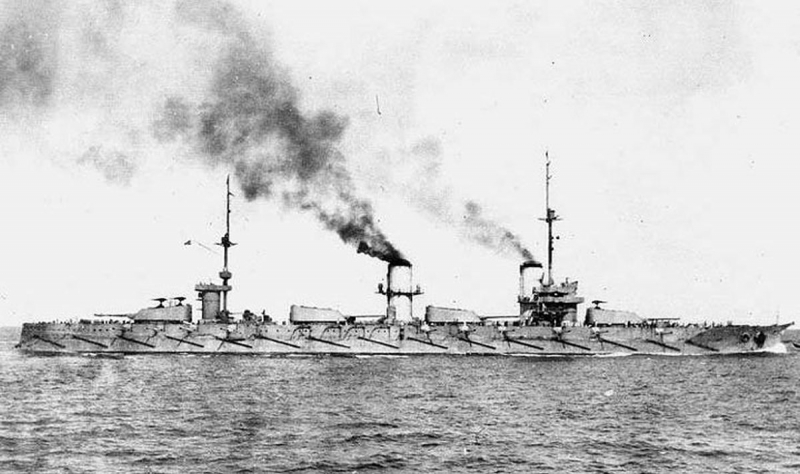Enregistrez-vous
ARMATEURS PASSES
ARMATEURS PRESENTS
NAVIRES MARCHANDS
NAVIRES MILITAIRES
OFF-SHORE
AUTRES IMAGES

| Précedente Suivante |
 |
| Imperatritsa Ekaterina Velikaya |
| History Russian Empire Name: Ekaterina II Namesake: Catherine the Great Operator: Imperial Russian Navy Builder: ONZiV Shipyard, Nikolayev Laid down: 30 October 1911 Launched: 6 June 1914 Commissioned: 18 October 1915 Renamed: ? Imperatritsa Ekaterina Velikaya (Empress Catherine the Great) 27 June 1915 ? Svobodnaya Rossiia (Free Russia) 29 April 1917 Russian SFSR Name: Svobodnaya Rossiia (Free Russia) Operator: Red Fleet Acquired: November 1917 Fate: Scuttled 18 June 1918 General characteristics Class and type: Imperatritsa Mariya-class battleship Displacement: 24,644 long tons (25,039 t) Length: 167.8 m (550 ft 6 in) Beam: 28.07 m (92 ft 1 in) Draft: 8.7 m (28 ft 7 in) Installed power: 27,000 shp (20,000 kW) Propulsion: 4 shafts, 4 steam turbines, 20 Yarrow water-tube boilers Speed: 21 knots (39 km/h; 24 mph) Range: 1,680 nautical miles (3,110 km; 1,930 mi) at 21 knots (39 km/h; 24 mph) Complement: 1,154 Armament: ? 4 ? 3 - 12-inch (305 mm)/52 guns ? 18 ? 1 - 130-millimeter (5.1 in)/55 guns ? 3 ? 1 - 75-millimeter (3 in) AA guns ? 4 ? 1 - 17.7-inch (450 mm) submerged torpedo tubes Armor: ? Waterline belt: 125?262.5 mm (4.92?10.33 in) ? Deck: 9?50 mm (0.35?1.97 in) ? Turrets: 250 mm (9.8 in) ? Barbettes: 250 mm (9.8 in) ? Conning tower: 300 mm (11.8 in) The Imperatritsa Ekaterina Velikaya (Russian: Императрица Екатерина Великая, or Empress Catherine the Great) was the second ship of the Imperatritsa Mariya-class dreadnoughts of the Imperial Russian Navy. She was begun before World War I, completed in 1915 and saw service with the Black Sea Fleet. She engaged the ex-German battlecruiser Yavuz once, but only inflicted splinter damage while taking no damage herself. She was renamed Svobodnaya Rossiya (Russian: Свободная Россия, Free Russia) after the February Revolution, but saw no further combat. She was evacuated from Sevastopol as the Germans approached in May 1918, but was scuttled in Novorossiysk harbor the following month when the Germans demanded that the Soviets hand her over according to the terms of the Treaty of Brest-Litovsk. Description Imperatritsa Ekaterina Velikaya was slightly larger than her half-sisters. She was 167.8 meters (550 ft 6 in) long at the waterline and had a beam of 28.07 meters (92 ft 1 in); 4 feet 10 inches (1.47 m) longer and 2 feet (0.6 m) wider than her half sisters. Her exact draft is not known, but she had a draft of 8.7 meters (28 ft 7 in) on trials. Her displacement was 24,644 long tons (25,039 t) at load, over 900 long tons (910 t) more than her designed displacement of 23,783 long tons (24,165 t). The first ship of the class, Imperatritsa Mariya, had proved to be very bow heavy in service and tended to ship large amounts of water through her forward casemates. The ammunition for Imperatritsa Ekaterina Velikaya's forward 12-inch guns was reduced from 100 to 70 rounds each while the forward 130 mm ammunition was reduced from 245 to 100 rounds per gun in an attempt to compensate for her trim. This sufficed as Imperatritsa Ekaterina Velikaya's longer length meant that she was less affected by the trim problem to begin with. Imperatritsa Ekaterina Velikaya was fitted with four Parsons-type steam turbines built by the Associated Factories and Shipyards of Nikolayev (ONZiV) with technical assistance from Vickers Limited. They were designed for a total of 27,000 shaft horsepower (20,000 kW), but produced 33,000 shp (25,000 kW) on trials. 20 mixed-firing triangular Yarrow water-tube boilers powered the turbines with a working pressure of 17.5 atm (257 psi). Her designed speed was 21 knots (39 km/h; 24 mph). Her maximum coal capacity was 2,000 long tons (2,032 t) plus 630 long tons (640 t) of fuel oil which gave her a range of 1,680 nautical miles (3,110 km; 1,930 mi) at full speed and 3,000 nautical miles (5,600 km; 3,500 mi) at economical speed. All of her electrical power was generated by three main Curtis 360 kilowatt turbo generators and two 200 kilowatt auxiliary units. Her main armament consisted of twelve Obukhovskii 12-inch Pattern 1907 52-caliber guns mounted in four triple turrets distributed the length of the ship. Her secondary armament consisted of eighteen 130-millimeter (5.1 in) B7 Pattern 1913 55-caliber guns mounted in casemates. They were arranged in two groups, six guns per side from the forward turret to the rear funnel and the remaining four clustered around the rear turret. She was fitted with three 75-millimeter (3.0 in) anti-aircraft guns, one mounted on the roof of the fore turret and two side by side on the aft turret. Four 17.7-inch (450 mm) submerged torpedo tubes were mounted, two tubes on each broadside abaft the forward magazine. Service Imperatritsa Ekaterina Velikaya was built by the ONZiV Shipyard at Nikolayev. She was laid down on 30 October 1911 as Ekaterina II, but this was just a ceremonial event as the design had not yet been finalized or the contract signed. ONZiV decided, on advice from Vickers, to increase her dimensions over those of her sisters to prevent her from being overweight. This added over two million gold rubles to her cost and delayed the start of her construction three months past her sisters. She suffered from a number of other delays during construction. First the method of fastening the armor to its supports was changed and the armor plates were locked together by a type of mortise and tenon joint to better distribute the shock of an impact. This was based on the full-scale armor trials conducted using the hulk of the old pre-dreadnought battleship Chesma in 1913 and added almost 500 long tons (508 t) of weight to the ship. She was launched on 6 June 1914, renamed on 27 June 1915, and completed on 18 October 1915. She ran her trials during the remainder of the year. She was nearly sunk by the Russian destroyer Bystry on 5 January 1916 when the destroyer fired seven torpedoes at her in a case of mistaken identity; luckily they all missed. Three days later she encountered the Ottoman battlecruiser Yavuz at long range. The ships opened fire at about 22,000 yards (20,000 m) and Yavuz only got off five salvoes before she disengaged from the slower Russian dreadnought without damaging her. Imperatritsa Ekaterina Velikaya fired 96 shells from her longer-ranged guns, but inflicted only splinter damage on Yavuz before she pulled out of range. Six months later both Imperatritsa Ekaterina Velikaya and her half-sister Imperatritsa Mariya, alerted by intercepted radio transmissions, sortied from Sevastopol in an attempt to intercept Yavuz as she returned from a bombardment of the Russian port of Tuapse on 4 July. Yavuz dodged north and avoided the Russians by paralleling the Bulgarian coastline back to the Bosphorus. After the February Revolution she was renamed Svobodnaya Rossiya (Russian: Свободная Россия, "Free Russia") on 29 April 1917. She sailed from Sevastopol to Novorossiysk on 30 April 1918 as German troops approached the city. The ship was scuttled on 19 June 1918 by four torpedoes fired by the destroyer Kerch in Novorossiysk harbor to prevent her from being turned over to the Germans as required by the Treaty of Brest-Litovsk. The fourth torpedo caused a massive explosion and she capsized and sank in four minutes. No attempt was made to salvage her during the 1920s, but the 12-inch shells were salvaged from her wreck. Explosive charges were used to gain access to her magazines until one day in 1930 when a charge set off a torpedo warhead, which caused a nearby powder magazine to explode, throwing a column of water 100?120 metres (330?390 ft) into the air. No one was injured, but salvage work of this type ceased, although parts of her engines and boilers were later salvaged. |
| Username | |
| Armateur | Imperial Russian Navy |
| Ship manager | |
| Numéro IMO | |
| Type de navire | Battleship |
| Année et chantier de construction | 1915 ONZiV Shipyard, Nikolayev |
| Date | |
| Lieu | |
| Téléchargée le | 11/10/2016 |
| Dimension | 1200 x 710 |
| visites | 1552 |















